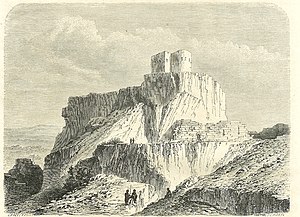Lambron
| Lambron | ||
|---|---|---|
|
Drawing by Victor Langlois (19th century) |
||
| Alternative name (s): | Les Embruns, Namrun | |
| Castle type : | Felsenburg, Spurlage | |
| Place: | Çamlıyayla | |
| Geographical location | 37 ° 10 '4 " N , 34 ° 36' 12" E | |
|
|
||
Lampron or Lambron ( Armenian Լամբրուն Պերդ ) was an Armenian castle in the Taurus . The Franconian name is "Les Embruns" , the Arabic Namrun .
location
The castle is located near Çamlıyayla , around 60 km north of Tarsus in the province of Mersin , on a boulder at the end of a narrow rock spur of the Bulgar Dag , and formed the key to the Cilician Gate , as it was considered impregnable.
history
The oldest known complex is Byzantine . Without excavations, it cannot be determined whether there were older predecessor buildings; given the location, this is very likely.
The castle was given to the Hethumid Oschin in 1072 by Abul Gharib , the Byzantine governor of Tarsus . Samuel von Ani would later claim that he had taken the fortress from the “Saracens” ( Seljuks ), who at that time had not yet penetrated into the Taurus (Cheynet 1996). Oshin, like his rival Ruben, held the title of sebastos in eastern Cilicia .
From 1171 to 1172 the castle was besieged by the Rubenid Mleh after Hethum had chased away his wife, Mleh's niece. 1183 besieged Ruben III. the fortress again. Hethum called Bohemond of Antioch to help. The latter treacherously captured Reuben during a feast in Antioch, but Reuben's brother Lewon continued the siege, but could not take Lambron despite all efforts.
After he became king, he pretended to wed his niece Philippa, Rubens' daughter, to Oschin, Hetum's eldest son. During the wedding celebrations in Tarsus, Lewon was then able to take the castle, which had been exposed by its defenders. He forced Hethum to enter the Drazark Monastery . He handed Lampron over to his mother, Rita von Barberon, allegedly because he feared that any vassal he enfeoffed with the fortress would rebel against him, as it was impregnable. Philippa would later marry Theodor Laskaris .
Through the forced marriage of Zabel , Lewon's daughter, with Hethum I , Lambron came to the Constantine of Constantine from a younger branch of the Hethumids. In 1291 Konstabel Konstantin gave the castle to Konstantin, the son of Hethum, whom Lewon had forced into the monastery. But Lewon's saying turned out to be true. In 1235 Constantine of Lambron allied himself with Kai Chosrau III. against King Hethum, who had allied himself with the Mongols and took Tarsus. But he had to withdraw again. But it was not until 1250 that the king managed to capture him and, despite papal protests, kill him.
When and how the castle fell to the Mamluken is unknown.
investment
The castle has an irregular lens shape and occupies an area of 330 x 150 m. It is approx. 50 m above the valley floor. It is protected from the spur in the north by a ditch carved into the rock, which is between 16 and 25 m wide. The terraced western side offers the easiest access, here the walls are strongest. The complex consists of a castle and a bailey. The only access is in the west, and there is also an exit gate .
The vaults of the residential buildings are still partially preserved. Some of the rooms were equipped with a hypocaust .
literature
- FCR Robinson, PC Hughes: Lampron. Castle of Armenian Cilicia. In: Anatolian Studies 19, 1969, pp. 183-207.
- Jean-Claude Cheynet: Les Arméniens de l'empire en Orient de Constantin Xe à Alexis Comnene (1059-1081) . In: L'Armènie et Byzance . Paris, 1996, pp. 67-78.

